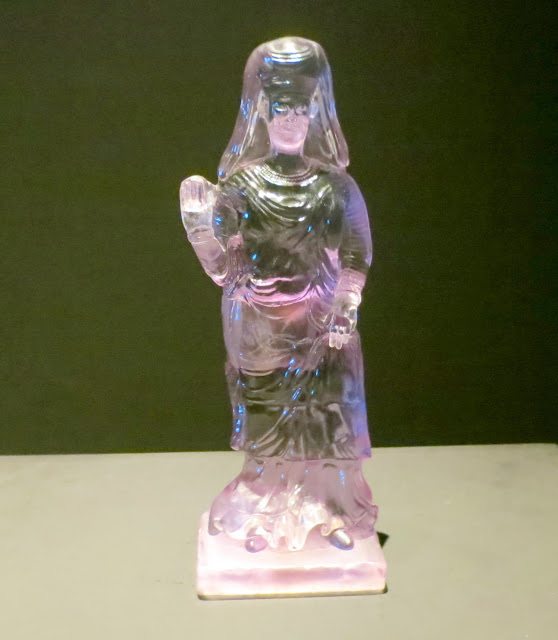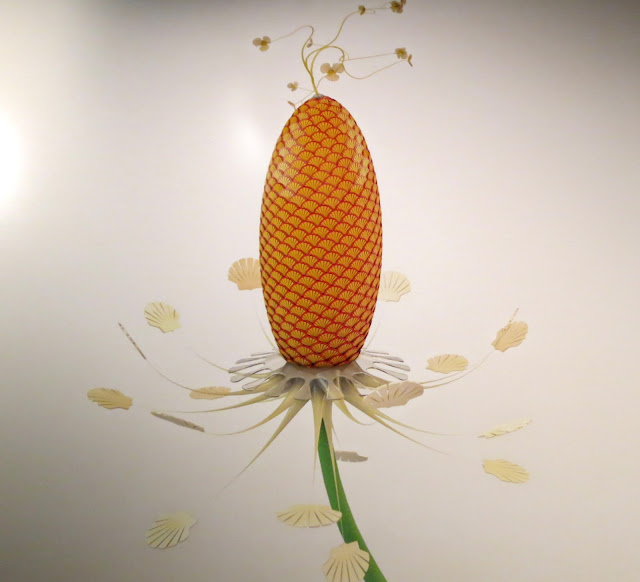Hybrids: On the Borderline between Art and Technology
at the Onassis Cultural Centre, Athens.
This exhibition was great fun as well as being thought-provoking. The curators state that: 'our societies, our perceptions, our bodies are increasingly not only mediated by, but merged with different kinds of technological systems either digital or material. Such technologies are increasingly made not just of hardware and software but also of other living organisms and biological material.... These new approaches also necessitate new definitions and taxonomies, or even a new language, and ultimately, a new way of looking at our world.
The exhibition invites a broader reflection on what agency means in a post-humanist era: what emancipates and what controls our living.
In Hybrids, the accent is on merging different media and genres into new forms of artistic expression, on crossing the boundaries between art and research, on social and political commitment and activism'.
The timing of this exhibition was particularly pertinent for us as we have been watching Charlie Brooker's Black Mirror, a series, a dystopia about the impact technology will have on our future and about the issues, the ethical issues, surrounding the technology.
Hybrid Realities:
Social Soul, by Lauren McCarthy and Kyle Macdonald:
We walked through a dark corridor, entered Ken's twitter username on a screen, and walked into the ultimate infinity room. The aim of this installation is to look into social media and online platforms and computer-controlled algorithms in general.


The installation brings to life a user's twitter stream in an immersive structure where their social media life is on display in a 36-degree stream of monitors, mirrors and sound.

We were immersed in Ken's twitter feed, which is a professional one, related to his publications.

A custom algorithm is used to match participants with other visitors so at the exit we were given Ken's 'soul mate' with an encouragement for online connections and conversation.
This artwork undermined the idea of having a company 'on paper' in countries considered financial offshore centres. The artist unveiled over 200,000 Cayman Islands companies and reversed global finance machinations through conceptual art.
The website Loophole4All.com promoted the sale of real identities of anonymous Cayman companies at low cost to democratise the privileges of offshore businesses by forging Certificates of Incorporation documents for each company, all issued with the artist's real name and signature. This performance generated international media attention, engaged an active audience and drew outrage from authorities on the Cayman Islands, international law and accounting firms, PayPal, and real owners of the companies.
Furthermore, the artist interviewed major experts and produced a video documentary investigating offshore centers to expose their social costs and to envision solutions to global economic inequality. In the offline art installation, the paper trail of the project is displayed with prints of the counterfeited Certificates of Incorporation and the documents of the scheme set up for the operation.
A Ship Adrift, by James Bridle:
A Ship Adrift is an artwork which uses the local weather to drive an imaginary airship across the choppy waters of the digital ocean. Driven by a weather station perched on the roof of the Onassis Cultural Centre, a weak and cantankerous artificial intelligence follows the wind to new points on the globe, picking up scraps of conversation, news and intelligence as it goes. It feeds on current affairs and Wikipedia entries; scrapes its bottom on the hidden shoals of social media; is helpless in the swirl of currents, digital and physical.

In the gallery space, the audience can follow its progress on a live map tracking its journey,

and read the ship's log as it evolves.

Can we find empathy in the experiences of artificial machines? Can we understand our world better when they explain it back to us? Can we ever, now, be truly lost? This installation is an attempt to answer these questions, and to attempt poetry in the spaces which join and separate us and our creations.
Humankind and Utopia:
Autophotosynthetic Plants:

This was the exhibition's centrepiece, a glass creation that looks like something out of a science fiction movie.

Sewage was taken from 12 districts of Athens, microorganisms were deployed to purify the polluted water, energy was generated thereby and, in turn, used to produce light to nurture the growth of the plant organisms in the globe in the middle of the contraption, in a self-sustaining cycle.
Body Paint, by Exonemo:
A staged tableau of a series of portraits featuring a person, nude, shaved, and painted entirely in a single shade of colour. The slight facial movements and the movement of the eyes alert us to the fact that these are real people, and not aliens.
Myconnect by Sasa Spacal, Mirjan Svagelj and Anil Podgornik:
O.k., so I don't completely understand the science, but this is what the blurb told us about this installation: 'Myconnect is an interspecies connector that emerged as an aspiration to enable human beings to transgress their own species and connect with another at a perceptive and physiological level. By entering the installation one joins with otherness, another multiplicity i.e. the fungal mycelium - the largest organism in the world. In the Myconnect capsule, a person's nervous system is integrated into a human-interface-mycelium feedback loop. The heartbeat of a person sets off the system in motion.
The signal travels to the mycelium where it is modulated in real-time and then returns to the human body via sound, light and tactile sensory impulses. These overwhelming stimuli that affect the nervous system cause an alteration of the heartbeat. With the altered heartbeat rate a new loop begins and circle is closed. Symbiosis of the signals begins'.
This is how experienced this installation: we entered the capsule and one of the exhibition staff attached all these electrodes to our head, arms, legs and finger and headphones to our heads.
The electrodes sent vibrations through our bodies which were in time to the weird sounds that came through the headphones. Lights pulsated in the capsule in time to the sounds and the vibrations. It was a weird experience that lasted 5 minutes.
Hybrid Remixed:
Material Speculation: ISIS, by Moreshin Allahyari:
Allahyari used 3-D printing to reproduce 12 statues from the Roman period in Hatra and Assyrian artifacts from Nineveh, two cities in what is now Northern Iraq which were destroyed by ISIS in the summer of 2015.
She has equipped each of the objects with a flash drive and a memory card containing background information (images, maps, pdf files and videos) about these cultural treasures. Like time capsules, each object is sealed and kept for future civilisations. This then becomes a tool both for resistance and documentation - a process for repairing history and memory.
Newsweek, by Danja Vassilev and Julian Oliver:
We had fun with this. The Newsweek device allowed us to edit and manipulate news 'fixing the facts' as they passed across the wireless network.

Fifty Sisters, by Jon McCormack:
An easily deceptive artwork. 50 one-square-meter prints with plants produced on the computer. On closer inspection the plants are made up of repeating building blocks of the seven large oil companies' logos that, as the 'Seven Sisters' cartel, controlled the oil industry until the energy crisis of the 1970s. The artwork uses multiple allusions: to the world economy's dependency on oil, to the all-pervasiveness in everyday life of oil-based products like plastic, to the environmental destruction on a massive scale caused by drilling and transporting oil.
Memory Overlay, by Afroditi Psarra and Marilena Georgantzi:
There was a technical problem with the jacket at the time of our visit so unfortunately we were unable to try it on.
Finally, the Shadowgram where the shadow or outline of any object or being can be instantly, and interactively fabricated into a vinyl sticker.
we posed and
got instant gratification.





























What an amazing experience this must have been!
ReplyDeleteIt was unique, fun and unexpected. We loved it, Olga.
Delete